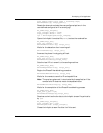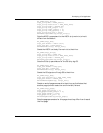
Developing a Fax Application
November 2009 66
args_admin.config_file_name = "usrcnfig.cfg";
BfvLineReset(lp,&args_admin);
Resets the channel and sets the user-configured options selected in
the user-defined configuration file named usrcnfig.cfg.
BT_ZERO(args_infopkt);
args_infopkt.fname = name;
args_infopkt.fmode = "w";
ips = BfvInfopktOpen(&args_infopkt);
Opens the infopkt-formatted file called name for writing.
BT_ZERO(args_tel);
args_tel.timeout = 0L;
BfvLineWaitForCall (lp, &args_tel);
Waits without a timeout for an incoming call and performs call
screening when the call occurs.
BfvLineAnswer (lp, &args_tel);
Takes the line off-hook and sets the line state to CONNECTED.
BT_ZERO(args_fax);
args_fax.r_ips = ips;
args_fax.local_id = local_id;
BfvFaxReceive (lp, &args_fax);
Receives fax pages and puts them into the infopkt stream ips.
BT_ZERO(args_infopkt);
args_infopkt.ips = ips;
BfvInfopktClose (&args_infopkt);
Closes the infopkt stream file after the file is received.
BT_ZERO(args_admin);
BfvLineDetach (lp, &args_admin);
Frees all memory for the attached line and closes the device.
Sending a Fax Using Low-Level Infopkt Function Calls One way to
send a fax using the low-level infopkt fax function calls is
demonstrated below. Each function is presented in sequential order,
and the action it performs is listed beneath it.
BT_ZERO(args_admin);
args_admin.unit = unit;
lp = BfvLineAttach(&args_admin);
Attaches to a free channel and gets a line pointer.


















